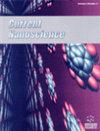Synthesis and Characterization of Carbon Nano Sphere-doped Gd: Alpha Sb2O4Nanostructure for High-Performance Energy Storage Applications
IF 1.5
4区 材料科学
Q4 BIOTECHNOLOGY & APPLIED MICROBIOLOGY
引用次数: 0
Abstract
To enhance the super capacitive properties of nanocomposites, the effective method is to combine carbon nanospheres with mesoporous structures with Gd3+:α-Sb2O4 inorganic nanocomposites (NC) to form hybrid electrodes. An as-prepared hybrid electrode material possesses increased energy density, high rate of reversibility and cyclic stability when incorporated in electrochemical cyclic voltammetric studies. In the present investigation, various wt % of C-nanospheres (Cx) (5 %, 10% and 20%) were decorated over Gd3+: α-Sb2O4 nanocomposites and were synthesized by coprecipitation method. XRD, SEM, EDX, UV-visible, and XPS are only a few of the analytical techniques used to describe the as-prepared hybrid nanocomposites. Electrochemical cyclic voltammetry was carried out in a 6M KOH solution, three-electrode system. The crystal structure and morphology of Cx: Gd3+@ α-Sb2O4 NC showed a mixed hexagonal phase and agglomerated tiny irregularly shaped morphology that appeared as the Cx concentration increased. Redshift in optical absorption peak appeared (near UV-edge), and the optical band gap (Eg) value increased from 3.53 eV to 3.65 eV. The electrochemical supercapacitor showed the highest specific capacitance of 989 F/g at the current density of 1 A/g for C20%:Gd3+@α-Sb2O4 NC compared with Cx:Gd3+@α-Sb2O4 (x = 5 % and 10 %) and undoped Gd3+:α-Sb2O4 NC. The change in phase angle and Rs value of 1.98 was attributed to the ideal supercapacitor properties. The cyclic stability after 5000 cycles with 79.71 % capacitive retention was exhibited by C20%:Gd3+@α-Sb2O4 NC. The present research introduces ease of synthesis of hybrid electrode materials possessing high active surface area, increased energy density, high cyclic stability, and reversibility in an aqueous solution.碳纳米球掺杂Gd: Alpha sb2o4纳米结构的合成与表征
为了提高纳米复合材料的超级电容性能,将具有介孔结构的碳纳米球与Gd3+:α-Sb2O4无机纳米复合材料(NC)结合形成杂化电极是有效的方法。制备的杂化电极材料在电化学循环伏安研究中具有较高的能量密度、高的可逆性和循环稳定性。本研究采用共沉淀法在Gd3+: α-Sb2O4纳米复合材料上修饰不同wt %的c -纳米微球(Cx),分别为5%、10%和20%。XRD, SEM, EDX, UV-visible和XPS只是用于描述制备的杂化纳米复合材料的几种分析技术。在6M KOH溶液、三电极体系中进行了电化学循环伏安法。Cx: Gd3+@ α-Sb2O4 NC的晶体结构和形貌表现为混合六方相,并随着Cx浓度的增加而出现微小的不规则形状的聚集形貌。光学吸收峰出现红移(近紫外边),光学带隙(Eg)值由3.53 eV增加到3.65 eV。与未掺杂Gd3+:α-Sb2O4 NC和Cx:Gd3+@α-Sb2O4 NC相比,C20%:Gd3+@α-Sb2O4 NC在电流密度为1 A/g时比电容最高,为989 F/g。相位角的变化和Rs值的1.98归因于理想的超级电容器特性。C20%:Gd3+@α-Sb2O4 NC在5000次循环后表现出79.71%的电容保留率。本研究介绍了易于合成的杂化电极材料,具有高活性表面积,增加能量密度,高循环稳定性和在水溶液中的可逆性。
本文章由计算机程序翻译,如有差异,请以英文原文为准。
求助全文
约1分钟内获得全文
求助全文
来源期刊

Current Nanoscience
工程技术-材料科学:综合
CiteScore
3.50
自引率
6.70%
发文量
83
审稿时长
4.4 months
期刊介绍:
Current Nanoscience publishes (a) Authoritative/Mini Reviews, and (b) Original Research and Highlights written by experts covering the most recent advances in nanoscience and nanotechnology. All aspects of the field are represented including nano-structures, nano-bubbles, nano-droplets and nanofluids. Applications of nanoscience in physics, material science, chemistry, synthesis, environmental science, electronics, biomedical nanotechnology, biomedical engineering, biotechnology, medicine and pharmaceuticals are also covered. The journal is essential to all researches involved in nanoscience and its applied and fundamental areas of science, chemistry, physics, material science, engineering and medicine.
Current Nanoscience also welcomes submissions on the following topics of Nanoscience and Nanotechnology:
Nanoelectronics and photonics
Advanced Nanomaterials
Nanofabrication and measurement
Nanobiotechnology and nanomedicine
Nanotechnology for energy
Sensors and actuator
Computational nanoscience and technology.
 求助内容:
求助内容: 应助结果提醒方式:
应助结果提醒方式:


